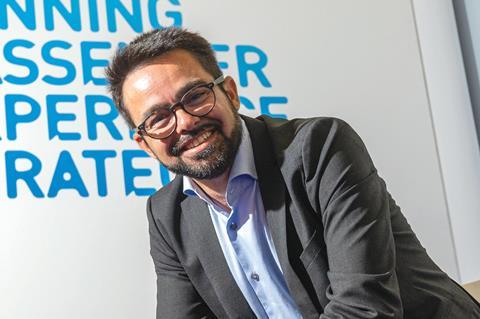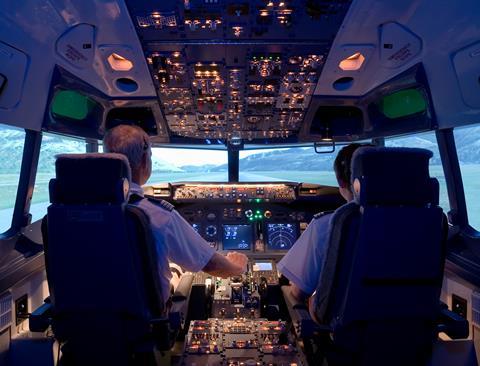SITA sees the impetus to cut aviation emissions as helping to drive the deployment of operational tools as well an opportunity to bring change to air traffic control.
While SITA has for many years developed in-flight connectivity solutions for passengers, SITA for Aircraft chief executive Yann Cabaret sees product aimed at operational gains driving much of its future opportunities.

“We are advancing our efforts slightly more to the front of the aircraft and the belly of the aircraft,” explains Cabaret, in an interview with FlightGlobal ahead of the show.
”The front of the aircraft is really around the pilots and how do we equip pilots to meet the demand that they have from their management and their passengers. So typically on-time performance, fuel efficiency, weather turbulence avoidance. That’s really where we see IT plus telecom joins up pretty well and where SITA has a role to play.
“The other bit we focus on is back to the OTP, turnaround on the ground,” he adds. “So how do you manage the turnaround, how do you manage an aircraft that has been re-routed to a different airport and how do you co-ordinate activities around the aircraft. That is really where we see our core of investment.”
Crucially, he believes moving of sustainability up the agenda – for regulators, the public and the aviation industry – provides greater impetus for take-up of some of SITA’s solutions.
“It is not like 10 years ago we didn’t know that sustainability wasn’t a topic, but socially and economically, all this is changing. So the drivers are more present today,” Cabaret says.
He says while much of the sustainability focus is on the role of new aircraft, engines and fuel types in driving net-zero ambitions, the industry can make gains in the nearer term by optimizing operations.
“It is a trendy example, but it is a real example. We have a product called SITA Optiflight, which provides recommendations to pilots in terms of speed and altitude to save fuel. The reality is every aircraft has a different performance profile. And we are not even talking types of aircraft, we are talking tails, because of its history and its own performance.
“So we use technology, we use flight data from each and every tail, to analyse performance, and then based on the weight of the aircraft or weather conditions, for each and every flight, we provide recommendations for speeds and altiutdes. And by applying those, pilots and airlines will save fuel.”
“We do this for Singapore Airlines, and on average they save 150kg of fuel on every take-off. In the big scheme of thing that may not be huge, but actually 150 kilos of fuel on every flight is something we can do today with currently technology, you don’t have to wait for SAF or new aircraft, or new engines, you can do it today.”
SITA has a product to optimse take-off and flight plans in-flight and further plans include using historical data to better predict the top of descent. “That is in our roadmap for 2023. Optimising top of descent allows you to do continuous descent operations and you have massive fuel savings there,” he says.

Helping make these solutions more practical today are advances in the data collected from the global fleet and machine learning capabilities.
“What has changed in the last 10 years is the generation of data from aircraft,” Cabaret says. ”The availability of aircraft performance data has increased and will continue to increase. And everything that relates to machine learning, The tools have become more available, in terms of machine learning tools and frameworks around using data.”
BRINGING IN AIR TRAFFIC CONTROL
One area SITA believes technology can make a difference to is air traffic control.
“Today, many of us – SITA and other providers – have solutions that are available to the pilots in the cockpit, or the OCC, the dispatcher. But what nobody really links is air traffic control, which is an area where IT has not moved . Having that link between dispatcher, pilot and ATC, there is one vision that I have for SITA, which is decision-making tools for all these people to work together.”
He believes an impetus to change in the way ATC operates will be preparing the ground for UAMs.
“Whether it comes in 10 years, 20 years or 40 years – everyone can have their own opinion of this. But what we know for sure is that the controller looking at the radar screen is not the future of air traffic control. There will still be controllers, but if you don’t help them, that’s not going to work well. So air traffic controller automation is another driver for change. This is going to drive the ATC world to different steps.”
Cabaret sees a possible pathway to development coming from the way the second screen in the cockpit has offered an easier way of providing more information to pilots without the bigger tasks of integrating it into the cockpit. “The question is can we do that in ATC? Can we put a second screen and somehow force that market to evolve?
“I don’t want to be cynical. I think they also want to evolve, there is a willingness to move,” he adds, flagging for example how it is working with Swiss ATC SkyGuide’s IT arm. “We have done a prototype with them, where we take to the recommendations we provide to pilots and we provide that in real time to control, so that they can make better decisions as well. That is how we push the ATC world to move a bit.”


























